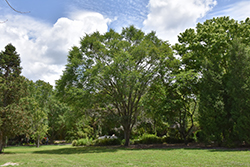It's all about ...
plants

Height: 40 feet
Spread: 30 feet
Sunlight:
![]()
Hardiness Zone: 7a
Description:
An impressive small to medium sized tree with an open-rounded crown; distinctive corky ridges form on opposite sides of the branches in one plane; an excellent, neat and tidy tree for the home landscape or street tree
Ornamental Features
Winged Elm has dark green deciduous foliage on a tree with a round habit of growth. The serrated pointy leaves turn yellow in fall.
Landscape Attributes
Winged Elm is a deciduous tree with a more or less rounded form. Its average texture blends into the landscape, but can be balanced by one or two finer or coarser trees or shrubs for an effective composition.
This is a relatively low maintenance tree, and is best pruned in late winter once the threat of extreme cold has passed. Gardeners should be aware of the following characteristic(s) that may warrant special consideration;
- Insects
- Disease
Winged Elm is recommended for the following landscape applications;
- Accent
- Shade
Planting & Growing
Winged Elm will grow to be about 40 feet tall at maturity, with a spread of 30 feet. It has a low canopy with a typical clearance of 4 feet from the ground, and should not be planted underneath power lines. It grows at a medium rate, and under ideal conditions can be expected to live for 70 years or more.
This tree should only be grown in full sunlight. It is very adaptable to both dry and moist locations, and should do just fine under average home landscape conditions. This plant will benefit from an application of bonemeal and/or mycorrhizal fertilizer at the time of planting. It is not particular as to soil type or pH, and is able to handle environmental salt. It is highly tolerant of urban pollution and will even thrive in inner city environments. This species is native to parts of North America.
This plant is not reliably hardy in our region, and certain restrictions may apply; contact the store for more information.
